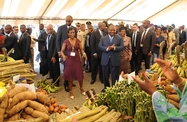Gabon introduces new policies for agriculture sector
 En Français
En Français
The recent ratification of the Comprehensive Africa Agriculture Development Programme (Programme Détaillé pour le Développement Agricole en Afrique, PDDAA) by Gabon is a step towards increasing output in one of the government’s priority sectors.
Introduced in 2003 by the New Partnership for Africa’s Development, the PDDAA is an African Union (AU) development programme to promote investment in agriculture as a means of boosting the economy and reducing poverty across the continent.
Agriculture constitutes one of the largest employers in most AU member states and while arable land is often plentiful, agricultural productivity lags behind other emerging market regions such as Latin America and Asia. Many countries in West and Central Africa are heavily dependent on imports for even staple foods.
Despite its 5m ha of unused agricultural land, favourable climate and abundant rainfall, for example, Gabon imports the vast majority of its food needs, at a cost of around CFA150bn (€225m) per year. As a result, the PDDAA encourages member states to devote 10% of the national budget to agriculture and aims for 6% annual growth in the sector through both capital spending and improved efficiencies.
Gabon was the fourth of 10 states in the Economic Community of Central African States (Communauté Économique des États de l’Afrique Centrale) to sign on to the PDDAA in May. The Ministry of Agriculture (MoA) has announced that to meet PDDAA goals, Gabon must invest an average of CFA30bn-40bn (€45m-60m) per year over the next 10 years. The amount of public financing has not been specified, but a significant portion is expected to come from the private sector and international partners.
With its adoption of the PDDAA, Gabon has launched a process to create an overarching sector development strategy: the National Plan for Agricultural Investment and Food and Nutritional Security (Programme National d’Investissement Agricole et de Sécurité Alimentaire et Nutritionnelle).
Although details have yet to be finalised, key elements of the programme include reducing reliance on food imports, boosting revenue from agricultural exports and creating new employment opportunities. The strategy will flow from the broader goals outlined under Gabon Vert, the agricultural component of the national economic development plan, Emerging Gabon (Plan Stratégique Gabon Émergent), which aims to boost the sector’s contribution to GDP from 5% to 20% by 2020.
However, the agricultural plan will set more specific production targets and propose a number of projects to be completed, each of which will be matched to an investment budget. The strategy is similar to Morocco’s Plan Maroc Vert, with which it shares many of the same goals.
The Gabonese authorities have introduced several national agricultural and food security policies in the last decade, although their impact has been comparatively modest. These include Gabon Vert, as well as specific initiatives that outline objectives for domestic crop production, food security standards and fisheries activity (also known as Gabon Bleu). The government announced in early June that it would create a National Agency for Food Security (Agence Gabonaise de Sécurité Alimentaire), which will be part of the MoA and is expected to evaluate and prevent risks related to nutrition and food security.
The push to improve organisation, public spending and efficiency in the agricultural sector, mixed though the results have been, is part of a broader effort to increase activity in rural areas and reduce the country’s dependency on hydrocarbons, its primary revenue earner. This has been spurred in part by the fact that in recent years, the sector’s share of the national economy has plateaued. In 2010, for example, agriculture, animal husbandry and fisheries contributed a combined 3.8% of GDP, down from 4.4% in 2009.
Given the country’s comparative advantages, the potential for growth in the sector is significant and a number of investors – ranging from Singapore’s Olam to Belgian firm SIAT – are looking to exploit it, particularly in cash crop segments. Much work remains to be done, especially with regard to rural infrastructure, the spread of modernised techniques such as mechanisation, irrigation and the use of fertilisers, as well as agricultural logistics and human resources. However, the ratification of the PDDAA and efforts to draft a National Plan for Agricultural Investment and Food and Nutritional Security should provide the road map and financing targets necessary to jumpstart progress on sector goals.



